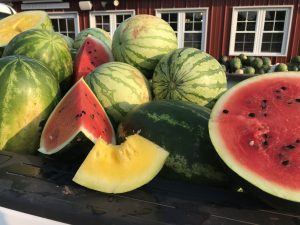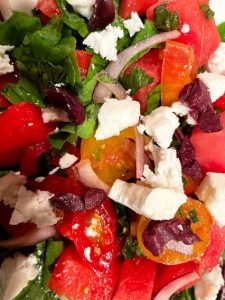One in a Melon!
One in a Melon!
Watermelon is quintessential with summer, not only for the time it is in season, but also for its ability to connect us with the nostalgia of our childhood. Most everyone can relate to a sentimental memory of eating watermelon on a hot summer day as a very special treat. It’s watermelon season on our farm… Read More »

Watermelon is quintessential with summer, not only for the time it is in season, but also for its ability to connect us with the nostalgia of our childhood. Most everyone can relate to a sentimental memory of eating watermelon on a hot summer day as a very special treat.
It’s watermelon season on our farm right now and typically have them available August through October. We farm 3 acres of watermelons growing 6 different kinds including Yellow Doll, Revolution, Sweet Polly, Mielheart, Yellow Buttercup, and Pata Negra. These varieties fall into the four major classifications of watermelons that are referred to as; seeded (or picnic), seedless, ice box (aka personal size or mini) and yellow/orange.
Watermelons are mostly known for their edible flesh, but did you know that every part of the watermelon is edible, including the seeds! The flesh, rind, and seeds are indeed edible and you’ll find recipes for watermelon rind pickles or jam readily available with much popularity. The seeds are said to be high in protein and have been known to be dried and ground into flour or roasted and eaten like a snack.
Watermelon’s cousins are the cucumber, pumpkin and squash and they are botanically classified as a fruit, meeting the criteria that they originate from flowers and contain seeds. Some gardeners refer to them as vegetables, why is that so? It’s because watermelons often grow alongside other summertime family of vegetables like corn & tomatoes!
Watermelons belong to the Citrullus Lanatus species of the Cucurbitaceae family, which are annual plants that trail or vine and bear tendrils. They are mostly monoecious, meaning they have separate male and female flowers so ultimately they rely on bees, wasps and other nectar loving insects to help them distribute pollen and ultimately bear fruit.
Aptly named, watermelons are almost all water making them a perfect refresher for hot summer months. They have been said to be rich in amino acids called citrulline that may help move blood through your body and are packed with water and nutrients while containing very few calories and making them exceptionally refreshing in Summer and appropriately helping you eat seasonally.
Mostly eaten fresh cut into chunks, watermelon can also be frozen and made into smoothies, drinks and cold soups. We all know that the best way to eat
Try this delicious watermelon and tomato salad for a no-cook summertime meal your family will absolutely love.
Best wishes from our farm kitchen to yours!







